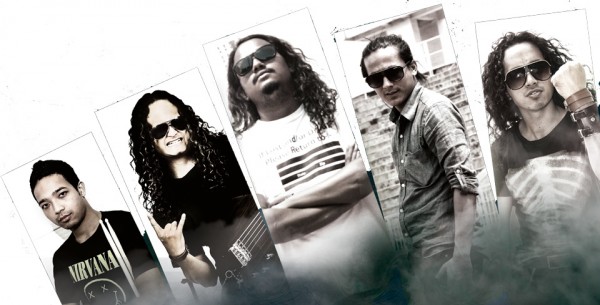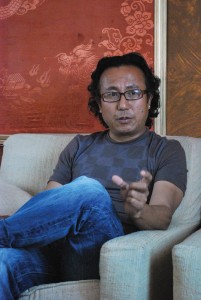They claim to be mainstream, but different from the rest. They made their mark by bringing Nepali rock anthems to life which earned them the accolade of best group and best performers in 2006. Then they disappeared. With two guitarists busy in Australia studying sound engineering, The Shadows Nepal took a break, performing only one tour together within the last three and half years. In this time new bands have formed endeavouring to fill the rock music void The Shadows left behind. Now, after a much anticipated and long wait, The Shadows are back ‘well nearly! Before rocking out to fans at home, The Shadows will embrace an Australian audience playing songs from both their second album, Hidne Manchhe Ladchha, and soon to be released third studio album.
Released in 2005, Hidne Manchhe Ladchha is a combination of hard and alternate rock. Making a point of representing real people and depicting real issues in their lyrics, The Shadows strike a chord amongst listeners who can relate to the different themes of their songs. This includes nature, navigating a new modernity, persevering against adversity, nepotism, humanism and peace.
I sit down with Swapnil Sharma, the lead singer of The Shadows Nepal, to find out a little bit more about the band, their impending Australian tour and what local fans can expect when they burst back onto the Nepali rock music scene at the end of the year.
I have been in Nepal for a while now and haven’t heard of the Shadows. Where have you guys been hiding?
We haven’t been hiding, we’ve just been apart and taking a break. Both the bass guitarist (Amit Pradhan) and lead (Prakash Rasaily) are in Australia, one in Melbourne and the other in Sydney, studying sound engineering so we couldn’t do much here in Nepal.
And what did you do in all that time?
We were in such a good spot when Amit and Prakash left that I wanted to maintain the momentum going and keep The Shadows visible to Nepali audiences. We hired a few different session guitarists who played with us at different events. But the guys did come back in 2010 for vacation. We played 10 concerts in all different parts of Nepal and received a huge response from the fans. We are definitely ready and motivated to do that again.
But first you have an Australian tour?
Yeah, it’ll be the first time we play overseas as a band, everyone is really looking forward it. Last year Amit and Prakash performed at a few festivals and in Nepali music programs in Melbourne and Sydney. They had a really good reception from both Nepali’s living in Australia and the locals.
So you have some fans there already?
It seems that way. Australia is a popular destination for Nepali students. Many would have known us years ago so they are waiting for us to come. Not many Nepali acts make it down there so I think they are nearly more excited than we are. Plus with the internet and facebook people can stay connected with the music even when they are not here. And I have a few friends who also live in Australia so it’ll be great to see them again.
Although the songs you compose are mostly Nepali, do you have plan to sing a few tracks in English for the Australian crowd?
I sometimes sing in English. The last track on Hidne Manchhe Ladccha, Looking at the Sky, is entirely in English and I do covers as well. But the most exciting thing for us as a band is that we’ll be performing some of the new songs from the next album. A few have been released as singles but we haven’t had much chance to play them live. Beyond that, though, it is hard to schedule songs. Much of being a rock band and performing live is that you have to read the crowd. You have to feel their energy; if they want fast, we’ll give them fast. If the mood is a little slower than we’ll tone it down a bit.
What is the creative process like for The Shadows ‘how do you compose the lyrics?
As the vocalist I tend to represent the band as the writer but most of the time it is a group effort. Everybody is always on the lookout for a new concept. Inspiration is everywhere. It could be from something you read while walking down the street or a conversation you have with someone. Our songs have a realistic, universal meaning so ideas can come from the everyday. Whenever I write songs I have to work at it for a while. To express social issues you have to go to many places and talk to many people.
What’s your favourite song?
My favourite is Prakriti. It’s a popular song related to saving the nature and how we are all linked to the environment in a certain way. Every time I perform it I make a point of talking about the messages the song contains, about how we represent ourselves as nature. The audience response is very positive.
Any plans for a new album?
Once we come back from the tour and then Amit and Prakash join us at the end of the year, we will have a lot of time to concentrate on performing at home and working on a third album. Actually we have already recorded seven tracks for the next album and a few, like Kheladi Hun Ma and Paisa, have been released as singles. There are lots of new bands on the scene now so it’ll be nice to get back out there.
What can audiences expect from the new album?
It is still important for us to create songs with meaning. In a way the third album explores similar issues to before but the songs are written based on the current situation. One song Naya Nepal Purano Gatibidhi, for example, looks at the politicians repeated request for a ‘new Nepal’ but the song highlights how their practices remain that of an old Nepal. We want to send a message that it’s not ok and we want people to realise this. We have already aired a few songs and have had a good response.
Something we didn’t do much of on the last album was play slower tracks. This time if we have to convey a soft message then will play something a little slower. But the feel of those tracks will still hit the audiences hard and with meaning; they give you more time to think.
Well enjoy Sydney. I would suggest going to the beach but it is winter now.
Thank you, I am sure I will. Even if it is winter and cold I have to go to the beach and jump in! We are landlocked here so it will be my first time to see the ocean.
The Shadows Nepal are touring Australia in July
23rd July in Melbourne at HiFi Bar
24th July in Brisbane at the Souths League Club
31st July in Sydney at Oxford Art Factory



